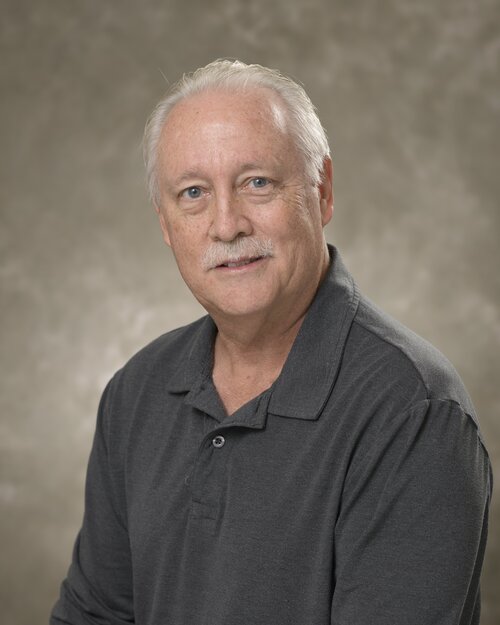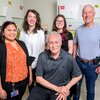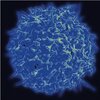
Contact Information
600 S Mathews Ave
Urbana, IL 61801
Research Interests
Research Topics
Molecular Immunology, Protein Dynamics, Protein Structure, Receptor Biochemistry, Toxins
Disease Research Interests
Cancer, Drug Discovery, Infectious Diseases
Research Description
Structure, Function, and Engineering of T Cell Receptors; Molecular Basis of Immune Recognition by T Cells; Tumor Targeting with T Cells; Engineering Protein Therapeutics
Research in our laboratory is directed toward understanding a fundamental issue in immunology: how mammals can eliminate millions of different antigens that are "foreign" (e.g. viruses, bacteria) without destroying antigens that are "self" (e.g. one's own tissues). The specific focus of the lab is on the antigen-specific receptor expressed by T lymphocytes (T cell receptor, TCR). The TCR is an αβ heterodimer that recognizes foreign peptides that are bound to products of the major histocompatibility complex (MHC). Foreign peptides can be derived from viral or bacterial antigens or in some cases from tumor associated antigens. For example, cytotoxic T cells recognize and kill tumor cells that express on their surface peptides bound to class I products of the MHC. Down regulation of the peptide/class I complex is one mechanism that tumor cells use to escape recognition and destruction. It has also become clear that the aberrant reactivities of some αβ TCRs can have severe autoimmune consequences. Rheumatoid arthritis and multiple sclerosis are two examples of diseases that involve the activity of T cells. Studies of the molecular processes involved in the expression of the αβ TCR and the biochemical interactions between the TCR and its ligands are essential to understanding and eventually controlling such detrimental responses.
A complete understanding of T cell recognition will require knowledge about the binding properties of T cell receptors. Unfortunately, the major limitation to such biochemical analyses has been the lack of pure receptor
protein. Our lab has engineered a "single-chain receptor" gene (scTCR) that contains the Vα and Vβ genes from a T cell clone linked by a gene that encodes a flexible peptide. The scTCR has been overexpressed in E. coli and a product of the appropriate molecular weight (~27 kD) has been identified. Our goals are to use these recombinant proteins to: 1) evaluate the binding affinities and specificities of the TCR, 2) use site-directed mutagenesis to map the binding site of the TCR, and 3) correlate the energy of TCR-peptide/MHC interactions with biological function. In another project, the TCR has been displayed on the surface of yeast cells. The yeast display system has been used to evolve more stable forms of the soluble TCR and to evolve TCR with higher affinities for their ligands. These high affinity TCRs have been used 1) to study the relationship between T cell function and TCR:ligand binding kinetics, 2) as probes for the presence of peptide-MHC complexes on tumor cells, 3) to inhibit undesirable T cell activity, and 4) to elucidate the structural contributions of different interactions to binding affinity.
Finally, our lab is interested in engineering other proteins of immunological
interest. These include the class I and class II MHC proteins, NK receptors, and antibodies against various T cell surface molecules. Proteins engineered for greater stability and higher affinity will be used to examine various structural and biochemical properties of the proteins, in addition to develop possible novel therapeutic agents.
Education
B.S. 1975 Illinois State University
Ph.D. 1982 University of Illinois, Urbana-Champaign
Postdoc. 1982-86 Massachusetts Institute of Technology
Additional Campus Affiliations
Philip A Sharp Endowed Professor Emeritus, Biochemistry
External Links
Highlighted Publications
Representative Publications
Sharma P, Kranz DM. Recent advances in T-cell engineering for use in immunotherapy. F1000Res. 2016 Sep 19;5. pii: F1000 Faculty Rev-2344. eCollection 2016. Review.
Harris DT, Wang N, Riley TP, Anderson SD, Singh NK, Procko E, Baker BM, Kranz DM. Deep Mutational Scans as a Guide to Engineering High Affinity T Cell Receptor Interactions with Peptide-bound Major Histocompatibility Complex.J Biol Chem. 2016 Nov 18;291(47):24566-24578
Bar-Or A, Steinman L, Behne JM, Benitez-Ribas D, Chin PS, Clare-Salzler M, Healey D, Kim JI, Kranz DM, Lutterotti A, Martin R, Schippling S, Villoslada P, Wei CH, Weiner HL, Zamvil SS, Smith TJ, Yeaman MR. Restoring immune tolerance in neuromyelitis optica: Part II. Neurol Neuroimmunol Neuroinflamm. 2016 Sep 7;3(5):e277.
Steinman L, Bar-Or A, Behne JM, Benitez-Ribas D, Chin PS, Clare-Salzler M, Healey D, Kim JI, Kranz DM, Lutterotti A, Martin R, Schippling S, Villoslada P, Wei CH, Weiner HL, Zamvil SS, Yeaman MR, Smith TJ. Restoring immune tolerance in neuromyelitis optica: Part I. Neurol Neuroimmunol Neuroinflamm. 2016 Sep 7;3(5):e276.
Posey AD Jr, Schwab RD, Boesteanu AC, Steentoft C, Mandel U, Engels B, Stone JD, Madsen TD, Schreiber K, Haines KM, Cogdill AP, Chen TJ, Song D, Scholler J, Kranz DM, Feldman MD, Young R, Keith B, Schreiber H, Clausen H, Johnson LA, June CH. Engineered CAR T Cells Targeting the Cancer-Associated Tn-Glycoform of the Membrane Mucin MUC1 Control Adenocarcinoma. Immunity. 2016 Jun 21;44(6):1444-54.
Harris DT, Singh NK, Cai Q, Smith SN, Vander Kooi C, Procko E, Kranz DM, Baker BM. An Engineered Switch in T Cell Receptor Specificity Leads to an Unusual but Functional Binding Geometry. Structure. 2016 Jul 6;24(7):1142-1154.
Harris DT, Kranz DM. Adoptive T Cell Therapies: A Comparison of T Cell Receptors and Chimeric Antigen Receptors.Trends Pharmacol Sci. 2016 Mar;37(3):220-30.
Adams JJ, Narayanan S, Birnbaum ME, Sidhu SS, Blevins SJ, Gee MH, Sibener LV, Baker BM, Kranz DM, Garcia KC. Structural interplay between germline interactions and adaptive recognition determines the bandwidth of TCR-peptide-MHC cross-reactivity. Nat Immunol. 2016 Jan;17(1):87-94
Mattis DM, Chervin AS, Ranoa DR, Kelley SL, Tapping RI, Kranz DM.Studies of the TLR4-associated protein MD-2 using yeast-display and mutational analyses. Mol Immunol. 2015 Dec;68(2 Pt A):203-12.
Sharma P, Wang N, Chervin AS, Quinn CL, Stone JD, Kranz DM.A Multiplex Assay for Detection of Staphylococcal and Streptococcal Exotoxins. PLoS One. 2015 Aug 25;10(8):e0135986.
Smith SN, Harris DT, Kranz DM. T Cell Receptor Engineering and Analysis Using the Yeast Display Platform. Methods Mol Biol. 2015;1319:95-141.
Stone JD, Harris DT, Kranz DM.TCR affinity for p/MHC formed by tumor antigens that are self-proteins: impact on efficacy and toxicity. Curr Opin Immunol. 2015 Apr;33:16-22.
Kranz DM, Sykulev Y. Herman N. Eisen: Mentor to many. Proc Natl Acad Sci U S A. 2015 Feb 10;112(6):1650-1.
Smith SN, Wang Y, Baylon JL, Singh NK, Baker BM, Tajkhorshid E, Kranz DM.Changing the peptide specificity of a human T-cell receptor by directed evolution. Nat Commun. 2014 Nov 7;5:5223.
Tosic V, Thomas DL, Kranz DM, Liu J, McFadden G, Shisler JL, MacNeill AL, Roy EJ. Myxoma virus expressing a fusion protein of interleukin-15 (IL15) and IL15 receptor alpha has enhanced antitumor activity. PLoS One. 2014 Oct 16;9(10):e109801.
Stone JD, Harris DT, Soto CM, Chervin AS, Aggen DH, Roy EJ, Kranz DM. A novel T cell receptor single-chain signaling complex mediates antigen-specific T cell activity and tumor control. Cancer Immunol Immunother. 2014 Nov;63(11):1163-76.
Hawse WF, De S, Greenwood AI, Nicholson LK, Zajicek J, Kovrigin EL, Kranz DM, Garcia KC, Baker BM. TCR scanning of peptide/MHC through complementary matching of receptor and ligand molecular flexibility. J Immunol. 2014 Mar 15;192(6):2885-91.
Sharma P, Wang N, Kranz DM. Soluble T cell receptor Vβ domains engineered for high-affinity binding to staphylococcal or streptococcal superantigens. Toxins(Basel). 2014 Jan 28;6(2):556-74.
Sharma P, Postel S, Sundberg EJ, Kranz DM. Characterization of the Staphylococcal enterotoxin A: Vβ receptor interaction using human receptor fragments engineered for high affinity. Protein Eng Des Sel. 2013 Dec;26(12):781-9.
Narayanan S, Kranz DM. The same major histocompatibility complex polymorphism involved in control of HIV influences peptide binding in the mouse H-2Ld system. J Biol Chem. 2013 Nov 1;288(44):31784-94.
Stone JD, Kranz DM. Role of T cell receptor affinity in the efficacy and specificity of adoptive T cell therapies. Front Immunol. 2013 Aug 21;4:244.
Smith SN, Sommermeyer D, Piepenbrink KH, Blevins SJ, Bernhard H, Uckert W, Baker BM, Kranz DM. Plasticity in the contribution of T cell receptor variable region residues to binding of peptide-HLA-A2 complexes. J Mol Biol. 2013 Nov 15;425(22):4496-507.
Schmitt TM, Aggen DH, Stromnes IM, Dossett ML, Richman SA, Kranz DM, Greenberg PD. Enhanced-affinity murine T-cell receptors for tumor/self-antigens can be safe in gene therapy despite surpassing the threshold for thymic selection. Blood. 2013 Jul 18;122(3):348-56.
Engels B, Engelhard VH, Sidney J, Sette A, Binder DC, Liu RB, Kranz DM, Meredith SC, Rowley DA, Schreiber H. Relapse or eradication of cancer is predicted by peptide-major histocompatibility complex affinity. Cancer Cell. 2013 Apr 15;23(4):516-26.
Stone JD, Chervin AS, Aggen DH, Kranz DM. T cell receptor engineering. Methods Enzymol. 2012;503:189-222.
Engels, B., A. S. Chervin, A. J. Sant, D. M. Kranz, and H. Schreiber (2012) Long-term Persistence of CD4(+) but Rapid Disappearance of CD8(+) T Cells Expressing an MHC Class I-restricted TCR of Nanomolar Affinity. Molecular Therapy. 20(3):652-60.
Aggen, D. H., A. S. Chervin, T. M. Schmitt, B. Engels, J. D. Stone, S. A. Richman, K. H. Piepenbrink, B. M. Baker, P. D. Greenberg, H. Schreiber, and D. M. Kranz (2012) Single-chain ValphaVbeta T-cell receptors function without mispairing with endogenous TCR chains. Gene Therapy, 19(4):365-74.
Stone, J. D., D. H. Aggen, A. S. Chervin, S. Narayanan, T. M. Schmitt, P. D. Greenberg, D. M. Kranz (2011) Opposite effects of endogenous peptide-MHC class I on T cell activity in the presence and absence of CD8. J Immunol. 186(9):5193-200.
Aggen, D. H., A. S. Chervin, F. K. Insaidoo, K. H. Piepenbrink, B. M. Baker, and D. M. Kranz (2011) Identification and engineering of human variable regions that allow expression of stable single-chain T cell receptors. Protein Eng Des Sel. 24(4):361-72.
Thomas, D. L., R. Doty, V. Tosic, J. Liu, D. M. Kranz, G. McFadden, A. L. Macneill, and E. J. Roy (2011) Myxoma virus combined with rapamycin treatment enhances adoptive T cell therapy for murine melanoma brain tumors. Cancer Immunol Immunother. 60(10):1461-72.
Bonsor, D. A., S. Postel, B. G. Pierce, N. Wang, P. Zhu, R. A. Buonpane, Z. Weng, D. M. Kranz, E. J. Sundberg (2011) Molecular basis of a million-fold affinity maturation process in a protein-protein interaction. J Mol Biol. 411(2):321-8.
Fuertes, M. B., A. K. Kacha, J. Kline, S. R. Woo, D. M. Kranz, K. M. Murphy, and T. F. Gajewski (2011) Host type I IFN signals are required for antitumor CD8+ T cell responses through CD8{alpha}+ dendritic cells. J Exp Med. 208(10):2005-16.
Stone, J. D., M. N. Artyomov, A. S. Chervin, A. K. Chakraborty, H. N. Eisen, and D. M. Kranz (2011) Interactions of streptavidin-based peptide-MHC oligomers (tetramers) with cell-surface T cell receptors. J Immunol. 187(12):6281-90.
Adams, J. J., S. Narayanan, B. Liu, M. E. Birnbaum, A. Kruse, N. A. Bowerman, W. Chen, A. M. Levin, J. M. Connolly, C. Zhu, D. M. Kranz, and K. C. Garcia (2011) T cell receptor signaling is limited by docking geometry to peptide-Major Histocompatibility Complex. Immunity. 35(5):681-93.
Persaud, S. P., D. L. Donermeyer, K. S. Weber, D. M. Kranz, and P. M. Allen (2010) High-affinity T cell receptor differentiates cognate pepMHC and altered peptide ligands with distinct kinetics and thermodynamics. Mol Immunol. 47(9):1793-801.
Wang, N, D. M. Mattis, E. J. Sundberg, P. M. Schlievert, and D. M. Kranz (2010) A single, engineered protein therapeutic neutralizes exotoxins from both Staphylococcus and Streptococcus. Clin Vaccine Immunol. 17(11):1781-9.
Cho, S, C. P. Swaminathan, D. A. Bonsor, M. C. Kerzic, R. Guan, J. Yang, M. C. Kieke, P. S. Andersen, D. M. Kranz, R. A. Mariuzza, and E. J. Sundberg (2010) Assessing energetic contributions to binding from a disordered region in a protein-protein interaction. Biochemistry. 49(43):9256-68.
Strandberg, K. L., J. H. Rotschafer, S. M. Vetter, R. A. Buonpane, D. M. Kranz, P. M. Schlievert (2010) Staphylococcal superantigens cause lethal pulmonary disease in rabbits. J Infect Dis. 202(11):1690-7.
Chervin, A. S., J. D. Stone, N. A. Bowerman, and D. M. Kranz (2009) Cutting edge: Inhibitory effects of CD4 and CD8 on T cell activation induced by high-affinity noncognate ligands. J Immunol. 183(12):7639-43.
John, C. C., M. Niermann, B. Sharon, M. L. Peterson, D. M. Kranz, and P. M. Schlievert (2009) Staphylococcal toxic shock syndrome erythroderma is associated with superantigenicity and hypersensitivity. Clin Infect Dis. 49(12):1893-6.
Recent Publications
Ranoa, D. R. E., Sharma, P., Schane, C. P., Lewis, A. N., Valdez, E., Marada, V. V. V. R., Hager, M. V., Montgomery, W., Wolf, S. P., Schreiber, K., Schreiber, H., Bailey, K., Fan, T. M., Hergenrother, P. J., Roy, E. J., & Kranz, D. M. (2023). Single CAR-T cell treatment controls disseminated ovarian cancer in a syngeneic mouse model. Journal for ImmunoTherapy of Cancer, 11(5), Article e006509. https://doi.org/10.1136/jitc-2022-006509
Schaettler, M. O., Desai, R., Wang, A. Z., Livingstone, A. J., Kobayashi, D. K., Coxon, A. T., Bowman-Kirigin, J. A., Liu, C. J., Li, M., Bender, D. E., White, M. J., Kranz, D. M., Johanns, T. M., & Dunn, G. P. (2023). TCR-engineered adoptive cell therapy effectively treats intracranial murine glioblastoma. Journal for ImmunoTherapy of Cancer, 11(2), Article e006121. https://doi.org/10.1136/jitc-2022-006121
Ranoa, D. R. E., Holland, R. L., Alnaji, F. G., Green, K. J., Wang, L., Fredrickson, R. L., Wang, T., Wong, G. N., Uelmen, J., Maslov, S., Weiner, Z. J., Tkachenko, A. V., Zhang, H., Liu, Z., Ibrahim, A., Patel, S. J., Paul, J. M., Vance, N. P., Gulick, J. G., ... Burke, M. D. (2022). Mitigation of SARS-CoV-2 transmission at a large public university. Nature communications, 13(1), Article 3207. https://doi.org/10.1038/s41467-022-30833-3
Sharma, P., Procko, E., & Kranz, D. M. (2022). Engineering Proteins by Combining Deep Mutational Scanning and Yeast Display. In Methods in Molecular Biology (pp. 117-142). (Methods in Molecular Biology; Vol. 2491). Humana Press Inc.. https://doi.org/10.1007/978-1-0716-2285-8_7
Smith, S. N., & Kranz, D. M. (2022). Engineering T Cell Receptors. (U.S. Patent No. 11384133).




